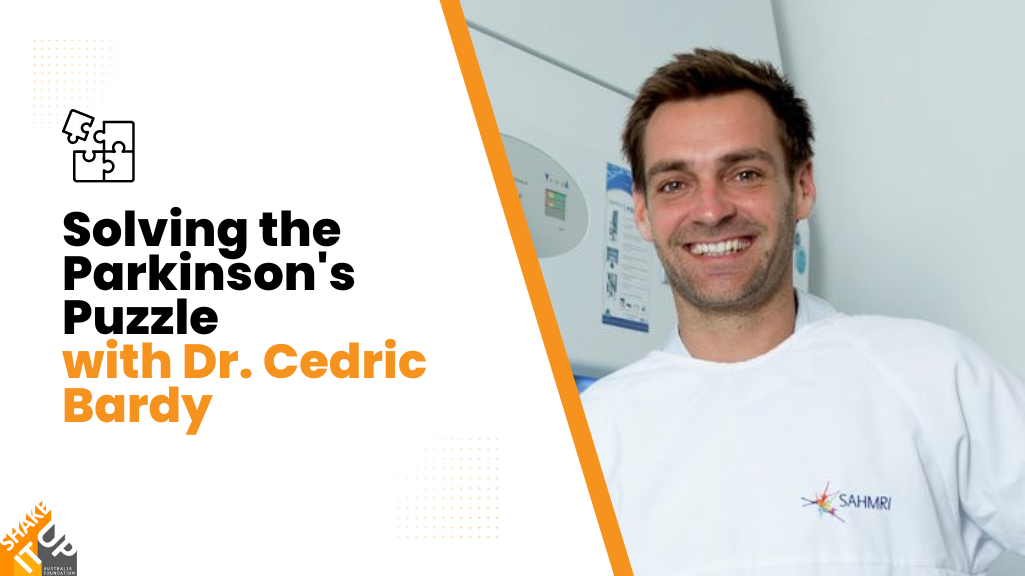
In this chat with Dr. Cedric Bardy, Associate Professor at SAHMRI (South Australia Health and Medical Research Institute) and Flinders University, we hear about his study into using live human neurons (brain cells) in a petri dish to examine the biological basis of Parkinson’s disease. The neurons are generated in the lab with non-invasive stem cell technologies. The idea is to prevent overload of electrical activity occurring in patient’s neurons to rescue energy levels, protect further neuronal losses and halt the progression of the disease.
Over 200,000 Australians are currently living with Parkinson’s disease, with a further 38 diagnosed everyday. It’s the fastest growing neurological disorder in the world, and there is still no cure. In our ‘Solving the Parkinson’s Puzzle’ series, we are speaking to leading Australian researchers to find out how their work is helping to slow, stop and ultimately cure Parkinson’s disease.
How is your work helping to solve the Parkinson’s puzzle?
My research team is working to discover ways to stop the progression of Parkinson’s disease. Parkinson’s is a complex disease that effects body movement – but the problem starts in the brain. Our research aims to understand why, and how, these problems start and happen. And ultimately, our goal is to help people with Parkinson’s disease feel better and move more easily.
How would you explain your research to a five-year old?
If I were to explain what I do to my daughter, or a five year old, I would tell her that we are like detectives trying to solve a puzzle. And the missing part of this puzzle is in the brain of people living with Parkinson’s.
How do you go about finding that missing piece of the puzzle?
Now we can’t just open up people’s skulls to find this missing piece, so for the last 10 years in collaboration with other researchers all over the world, we have worked to find ways to reverse engineer the human brain in a petri dish. So now we can take skin cells from someone with Parkinson’s and someone without Parkinson’s, reprogram them into stem cells, and then from those stem cells we can generate any kind of tissue we’re interested in. In this case, specifically brain tissue. So we end up with live human brain tissue from someone with Parkinson’s, and someone without, and we can compare them in a petri dish.
The progress we have made in this field is mind blowing and very exciting. We’re getting to the point where we can visualise the brain problems causing Parkinson’s disease, in these patient cells growing in the petri dish. And the beauty is that it can not only help us understand this complex disease, but it also gives us the opportunity to safely test new ideas and drugs on the patient brain avatars – without putting anyone at risk. So this new kind of research lets us test ideas outside the box. For example, right now we’re exploring the potential therapeutic value of specific venoms, finding spiders, snakes and all kinds of venomous species and we can only do that with this kind of model.
What is the next step of your research project?
The goal first is translation, but we need to get it right, and we are doing everything we can to validate our ideas first in patient brain avatars, before moving to clinical trials.
How will your research help someone living with Parkinson’s in 10 years time?
In the next 10 years, I hope obviously we can find a treatment to stop Parkinson’s disease progression, but the truth is we may have already! The challenge is how to make sure we translate these discoveries into clinical use. I believe our research is about to transform how we do clinical trials. Right now it’s still very hard to predict which patients will respond to a drug, and who won’t. This is a huge problem. Because if a drug works on some people, but not the majority, the trial will most likely be deemed unsuccessful, and put aside. So, suppose we better understand the drug mechanism on different individuals. In that case, we could only give the drug to a patient that has the highest chance to benefit from it. The best way to solve this in my opinion, is to integrate a brain avatar model into clinical trials.
In the next few years, I’m confident to predict that we’ll see this creative approach becoming more common practice. And I’m really excited to be a part of it!
How has the funding from Shake It Up helped to make your research a reality?
Obviously, the more resources we have, the faster we can move. Having Shake It Up in our corner, helping us to fund these resources while we scientists focus on the research is tremendous, and super important. For me, it’s not just about the funding that helps us move towards this goal, it’s also the collaboration we’re building with Shake It Up’s team and partners. The collaboration with Shake It Up boosts our motivation, and really helps us to keep thinking outside the box – and thinking bigger, and bigger.
Dr. Cedric Bardy says we're getting to the point of visualising what's causing #Parkinsons, giving scientists opportunities to safely test new ideas and drug treatments Click To Tweet

